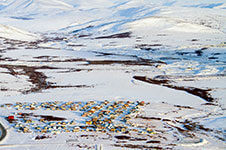Many Alaskans know that Quintillion has built a fiber optic cable system in the northern region of Alaska, but there is still much confusion on how this network fits into the big picture of bringing broadband to the Alaska Arctic. Quintillion doesn’t actually sell or provide internet services to consumers – so what does our network achieve?
Quintillion is a middle-mile provider, which means we serve as the middleman between the public internet and Alaskans. While Alaskan residents will never receive a monthly bill from us for internet service, our fiber optic cable system plays an essential role in getting broadband to Alaskan homes and businesses in the North Slopes and other rural areas of Alaska.
Overview of Middle Mile Transport
Middle-mile transport is the segment of broadband networks that connect end-users to the internet. In other words, the connection you get at your home or business is not directly connected to the global public internet. Rather, each location is connected to the internet via a regional backbone – which is often referred to as backhaul, middle mile, or transport.
The infographic below provides a helpful visual of where the middle mile fits into the larger picture of how the internet works. There are multiple options for middle-mile transport, including subsea fiber, terrestrial fiber, satellite, and terrestrial microwave solutions, and this link is necessary to deliver services to consumers’ homes.
This is why investments in middle-mile networks are so essential – even if last-mile internet providers were able to provide a wireless, cable, or fiber internet solution for every home or business in Alaska, this infrastructure relies on high-quality middle-mile networks to provide affordable, high-speed internet to Alaskans.

Middle-Mile in Alaska: Quintillion’s Analogy
To help our readers better understand the relationship between middle and last-mile networks and how this affects end-users in Alaska, we interviewed Quintillion’s Senior Manager of Government Programs, Ariel Burr.
She explained that the segmentation of telecommunications is similar to a road system. For broadband to travel to a person’s location, it must travel down the highways and interstates that connect states, which is similar to what we call middle mile, backhaul, or transport capacity. The side streets and neighborhoods that take you to an individual’s home are the last mile.
What is happening in many villages across Alaska is that people may have access to last-mile service, but there is no middle mile network to connect to – meaning the neighborhoods and side streets are accessible, but they don’t hook up to highway that leads back to internet sources in the lower 48.
Another analogy we like to use at Quintillion is to compare the unique broadband situation in Alaska to a water supply system. In some areas of Alaska, every home may have the four-inch pipe they need to accept water (broadband) into their homes, but the entire village is hooked up to a garden hose, so there simply isn’t enough middle mile to serve the entire community. This leads to issues like incredibly expensive internet service, low speeds, and limited bandwidth.
How Alaska Broadband Funding Fits In
When funding or grants are given to underserved communities that provide free data or discounted internet service, they’re just addressing the last-mile network – or beefing up the side streets and roads. Until the necessary infrastructure is built in these locations that provide middle-mile transport, rural Alaskan communities cannot get reliable internet access.
While there are middle-mile gaps in other parts of the country, Alaska is unique in how much middle-mile infrastructure is missing. For people in the lower 48, it can be difficult to comprehend just how rural and remote these locations in Alaska are. In some parts of the country, rural may mean that it’s an hour drive to the nearest city. In Alaska, rural can mean two flights or an 80-mile ride on a snowmachine through ice roads to get to the nearest village.
While last-mile initiatives may be the answer underserved communities in other states need, Alaska’s most urgent need is a more expansive middle-mile network. From here, we can work on extending these systems and providing service to individuals at their specific locations.
Quintillion’s Middle Mile Network in the Alaska Arctic

While there are many remote areas across Alaska that lack sufficient broadband access, the North Slopes was one of the most unserved locations in the state. Quintillion is the first and only telecommunications provider to build a fiber middle mile network in the Alaska Arctic, connecting 1000s of Alaskans to high-speed broadband for the first time.
This network spans a total of 1700 miles, including 1200 miles of subsea fiber that spans from Nome to Prudhoe Bay, and 500 miles from Prudhoe Bay to Fairbanks. At Fairbanks, the network connects to existing networks that reach Anchorage, Seattle, and Portland – serving as the link to the Public Internet.
When it comes to middle-mile infrastructure, fiber optics is the most affordable and best option available. While microwave and satellite middle-mile solutions also play a vital role in closing connectivity gaps in Alaska and across the country, fiber optics provides unparalleled security, reliability, latency, bandwidth capacity, and speed.
Not only does Quintillion’s fiber optic cable network provide service to Alaskans living in Nome, Kotzebue, Point Hope, Wainwright, Utqiaġvik, and Prudhoe Bay/Deadhorse — including the oil and gas infield — it also plays a vital role in national security and military operations in the Arctic. Faster broadband in the Arctic enables more advanced early warning systems, reliable communication, positioning capabilities, and regional development. For this reason, Quintillion’s fiber optic cable network has been designated critical infrastructure by the Department of Homeland Security.
Quintillion and Alaskan Last Mile Providers
Since Quintillion’s system is a middle mile network, we don’t directly provide internet service to Alaskan consumers. Rather, internet service providers (ISPs) use our fiber to deliver high-speed internet to their customers.
Almost every ISP in the state of Alaska connects to Quintillion’s infrastructure, including ACS, GCI, ASTAC, DRS, and TelAlaska. By working with a wide range of ISPs, our network helps encourage competition and bring down costs for end-users.
Additionally, some of our partners also have their own middle-mile infrastructure in a few of the locations we serve. Having more than one middle-mile system only benefits these areas, as this increases redundancy and provides a backup solution in case one network has an outage.
Quintillion’s Dedication to the Alaska Community
Quintillion’s fiber optic cable network enables Alaskans in the most remote areas of the state to access digital services that were once unavailable to them. This has opened up countless opportunities for families, students, working professionals, businesses, tribal organizations, emergency responders, and local governments. With an expansive middle-mile system comes high-speed internet services that better serve people’s needs at a more affordable cost.
At the core, our mission at Quintillion is to support rural communities in Alaska, help drive economic growth, and connect people to the resources they need. Our fiber optic cable network has played a major role in bringing connectivity to the Alaska Arctic and will only continue to make a bigger impact in the communities we work in.
Need to reach out to someone at the Quintillion team? Connect us with us here.















